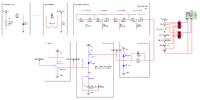iceblu3710
Member level 3
How do DSO's take a +-30V input signal and scale it so that the output swing is no more than the internal components, say 5V?
The only way I can think of is an opamp with programmable gain that when the input is <5V you have positive gain and >5V you need negative gain. Then put a couple zeners across the signal to protect things.
How do the pro's deal with this issue?
The only way I can think of is an opamp with programmable gain that when the input is <5V you have positive gain and >5V you need negative gain. Then put a couple zeners across the signal to protect things.
How do the pro's deal with this issue?

